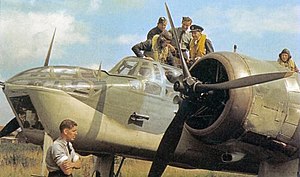Bristol Blenheim
| Blenheim (Types 142M, 149, 160) |
|
|---|---|
 |
|
| Blenheim Mark IV of 21 Squadron at Bodney in August 1941 | |
| Role | Light bomber / fighter |
| Manufacturer | Bristol Aeroplane Company |
| Designer | Frank Barnwell |
| First flight | 12 April 1935 |
| Introduction | 1937 |
| Retired | 1944 (United Kingdom) 1956 (Finland) |
| Primary users |
Royal Air Force Royal Canadian Air Force Finnish Air Force Royal Yugoslav Air Force |
| Number built | 4,422 |
| Variants |
Bristol Beaufort Bristol Fairchild Bolingbroke |
|
|
|
|
|
|
|
|
The Bristol Blenheim is a British light bomber aircraft designed and built by the Bristol Aeroplane Company that was used extensively in the first two years of the Second World War. It was originally developed as the civil-orientated Type 142 in response to Lord Rothermere's challenge to produce the fastest commercial aircraft in Europe. First flying in April 1935, the Air Ministry was quickly impressed by its performance and ordered a modified design as the Type 142M to serve in the Royal Air Force (RAF) as a bomber. On 10 March 1937, deliveries of the newly named Blenheim commenced to RAF squadrons.
The Blenheim was one of the first British aircraft to feature an all-metal stressed-skin construction, retractable landing gear, flaps, a powered gun turret and variable-pitch propellers. The design of the Blenheim proved to be readily adaptable, and was modified to serve in roles such as an interim long-range fighter and as a night fighter, pending the availability of a more advanced fighter derivative of the Blenheim, the Beaufighter. A more capable bomber derivative, the Beaufort, was also developed, being both larger and heavier than the Blenheim.
A Canadian-built variant named the Bolingbroke was used as an anti-submarine patrol aircraft and trainer. The Blenheim Mk I outran most biplane fighters in the late 1930s but stood little chance against the German Messerschmitt Bf 109 during daylight operations of the Second World War, though it proved successful as a night fighter. The Mark IV variant was equally unsuccessful in its daylight bombing role, suffering many losses in the early stages of the war. The Blenheim was also used by a wide range of overseas operators, as well being produced under licence in Finland and Yugoslavia.
...
Wikipedia
